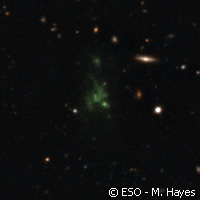ESO's VLT discovers mystery behind giant space blob brilliance
Scientists at the European Southern Observatory (ESO) have discovered how a rare vast cloud of glowing gas in the early Universe got its power. Presented in the journal Nature, the findings show that galaxies found within this giant 'Lyman-alpha blob', what astronomers describe as being one of the largest single objects known to man, provide the energy. The scientists used ESO's Very Large Telescope (VLT) to investigate the Lyman-alpha blob. According to them, these blobs are rare, immense and very luminous structures. They are usually seen in regions of the early Universe where matter is concentrated. The light that stems from such a blob is polarised, according to the team. Polarised light is used in 'everyday' life to generate three-dimensional (3D) effects in cinemas, for instance. This discovery is a first; not only does it reveal how polarisation is within a Lyman-alpha blob, but it provides insight into how blobs get their shine. 'We have shown for the first time that the glow of this enigmatic object is scattered light from brilliant galaxies hidden within, rather than the gas throughout the cloud itself shining,' says lead author Matthew Hayes of the University of Toulouse in France. Experts say the Universe is home to so many huge objects, with Lyman-alpha blobs being some of the largest ever. They are gigantic clouds of hydrogen gas with the capacity to reach diameters of a few hundred thousand light years (i.e. slightly bigger than the size of the Milky Way). They are also just as powerful as the brightest galaxies. The researchers say Lyman-alpha blobs are located at large distances. We see them as they were when the Universe was only a few billion years old, they add. So they play a significant role in helping us understand the formation and evolution of galaxies, at a time when the Universe was younger. The question, however, is where do they get their power to shine so brightly, and what is the nature of these blobs? In this study, the astronomers investigated what is considered one of the first and brightest blobs ever, called LAB-1. First discovered in 2000, its light has taken some 11.5 billion years to reach us because of its distance. It contains a number of primordial galaxies, including an active galaxy, and has a diameter of some 300 000 light years. Some researchers have said Lyman-alpha blobs shine when cool gas is pulled in by the blob's gravity and heats up. Others believe they shine because of the shiny objects found within. For instance, black holes are contained within that engulf matter, and the existing galaxies undergo star formations. According to the researchers, the embedded galaxies provide the energy to LAB-1, not the gas that is sucked in. They measured whether the light from the blob was polarised. Discovering how light is polarised gave them the answers they needed to determine the physical properties that generated the light. The information could also provide insight on what happened to it after it was created and before it reached Earth. 'These observations couldn't have been done without the VLT and its Focal Reducer and Low Dispersion Spectrograph (FORS) instrument,' says co-author Claudia Scarlata of the University of Minnesota in the United States. 'We clearly needed two things: a telescope with at least an eight-metre mirror to collect enough light, and a camera capable of measuring the polarisation of light. Not many observatories in the world offer this combination.' The researchers discovered that the light was polarised in a ring around the blob's central region, and not the actual centre. This effect would not have materialised if light stemmed from the gas falling into the blob under gravity. But it would emerge if the light comes originally from galaxies within the central region, before being scattered by the gas. The team plan to investigate these objects more thoroughly in order to see if their findings can be translated for other blobs as well.For more information, please visit:ESO:http://www.eso.org/public/Nature:http://www.nature.com/



